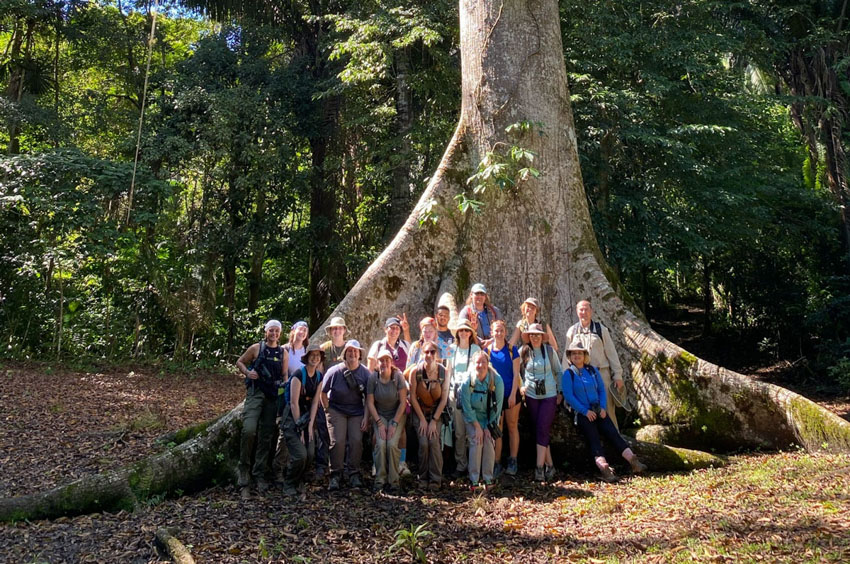USM Students Immersed into Diverse Ecosystems during Study Abroad Trip to Belize
Fri, 02/09/2024 - 10:04am | By: Ivonne Kawas

Students at The University of Southern Mississippi (USM) used the January 2024 intercession to immerse themselves into diverse ecosystems during a two-week tropical ecology study abroad trip to the Central American country of Belize.
USM professors of ecology and organismal biology in the School of Biological, Environmental, and Earth Sciences, Dr. Mac Alford (expert in botany) and Dr. Nicole Phillips (expert in marine biology), served as the guides for the students as they learned about the local tropical flora and fauna and visited several different ecosystems: coral reefs, pine savannahs, rainforests, and mangrove swamps.
“For many students, this study abroad class tends to be their first overseas experience, and our hope is that it changes their lives for the better,” said Dr. Phillips.

“We hope it broadens their horizons, opens them to new avenues of biological research, and fosters awareness of global environmental issues,” adds Dr. Alford.
Noah Williamson, a native of Hattiesburg, Miss., who is pursuing a double major in conservation biology and geography, reflects on how traveling to Belize enhanced his educational experience.
“The flora, fauna, and culture were entirely novel to me, and every new experience I had, every new critter I saw, left me in awe,” said Williamson. “As a student, I felt I learned far more on this trip than I could have in a lecture-based intersession. Learning in the field and immersing oneself in the culture of another country not only aids in the understanding and retention of concepts but also makes the learning experience much more fun!”
A Day in the Life in Belize
As soon as the students set foot in the tropics, they dive right into studying tropical ecosystems, biodiversity, and conservation.

Photo by Peter Kyne.
The day generally starts early with morning bird walks. Afterwards, students have breakfast and proceed to enjoying a plant hike. They take a lunchbreak and work on journaling and species identifications. This is followed by more hikes or work on hands-on experiments and research projects. Later, they have dinner and then go for a night walk to encounter nocturnal creatures.
On some days, students switch things up by exchanging the terrestrial adventures with marine experiences. They go snorkeling along the second-largest barrier reef in the world and engage in non-biological activities like cave tubing and visiting Maya historical sites. To engage with local communities, students visit with artisans who share their traditions and teach them how to make chocolate and Belizean rice and beans.
“My favorite part of the trip was definitely the early morning and late-night walks,” said Williamson. “While I knew there was great biodiversity in the tropics, nothing can compare to the experience of seeing it for yourself, which is exactly what we did on those walks. I woke up before dawn and went to bed well after dusk almost every night just to make sure I didn’t miss a single experience.”
The Diversity of the Tropics

Photo by Peter Kyne.
Home to thousands of species of exotic birds, wildlife, and flowers, students are exposed to sightings of unique and rare species. Dr. Alford highlights that this year marked an exceptional period for sightings compared to previous trips.
“During our expedition we identified 225 bird species,” said Dr. Phillips. “The excitement began with a crested guan, a welcomed sight, as they are becoming scarce in more populated areas due to hunting. The Cockscomb Basin Wildlife Sanctuary provides a protected haven for this turkey-sized bird and is one of the only places to see this species in Belize. The first morning also brought a delightful encounter with the national bird of Belize and one of the students’ favorites, the Keel-billed Toucan.”
As the group continued exploring, Dr. Alford says they encountered a rich tapestry of plant life, including a rare find in his years of teaching in Belize.
“A student spotted unique ladle-like structures on the ground, identified as bat-feeding nectaries from a woody vine (Marcgravia) high in the canopy — the first find in our years of teaching in Belize.”
To cap off the trip, Dr. Phillips notes that the challenges of nocturnal and elusive terrestrial species were met with notable sightings.
“Mammals can be particularly challenging in the tropics as terrestrial species are nocturnal and can be very elusive,” said Dr. Phillips. “With hikes in the evenings, we documented seeing species such as the Collared Anteater, Kinkajou, Gibnut, Agouti, White-nosed Coati, and various opossum species. Additionally, on the marine realm, we saw the West Indian Manatee and Bottlenose Dolphin.”
As the group bid farewell to Belize's natural wonders, Dr. Alford reinforces the invaluable role that experiential learning plays in the student journey.
“This trip, marked by exceptional sightings and newfound knowledge, has inspired our students, with many considering graduate education in biology or pursing research internships overseas.”
Learn more about upcoming Study Abroad trips.